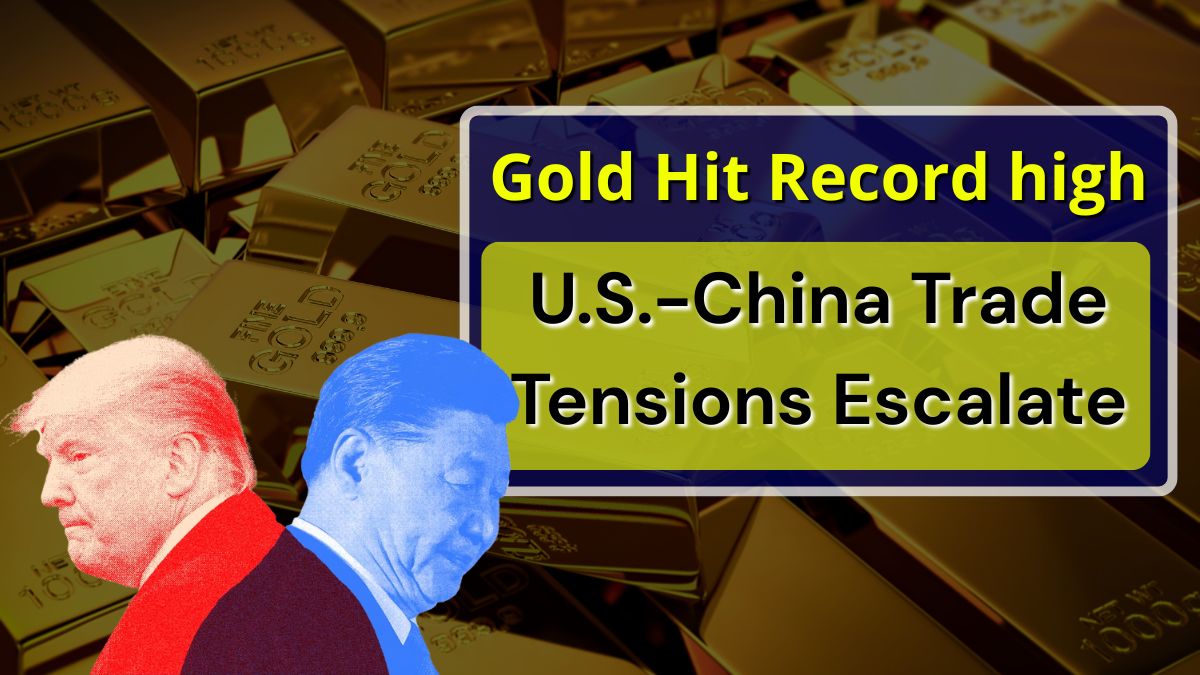Gold prices climbed to a new record high, hovering just below the $4,100 per ounce mark. That’s not just a number — it’s a loud signal that global markets are nervous. The trigger this time? A fresh wave of U.S.-China trade tensions that’s rattling confidence across the world.
Gold Prices Hit Record high
Spot gold surged 1.4% to $4,074.42 per ounce, while U.S. gold futures jumped 2.3% to $4,093.20. Even silver joined the rally, touching its own all-time high.
So, what’s behind this sudden gold fever? It’s simple — when uncertainty grows, investors park their money where it feels safest. Gold, often called the “ultimate safe haven”, shines brightest when everything else looks uncertain.
What Sparked the Tensions?
Late last week, U.S. President Donald Trump reignited the trade dispute with China. After Beijing imposed new export restrictions on rare earth materials, Trump responded with a sharp warning — a 100% tariff on goods imported from China and possible U.S. export controls on key software products by November 1.
He even hinted at skipping his planned meeting with Chinese President Xi Jinping later this month in South Korea, although the summit hasn’t been officially canceled yet.
These announcements unsettled global markets, sending investors straight toward gold. After all, when trade tensions rise, currencies and stocks often stumble — but gold tends to climb.
The Bigger Picture: A Tug of War Between Two Superpowers
This latest round of friction comes after a period of calm between Washington and Beijing earlier this year. But the peace didn’t last long.
Beijing defended its export restrictions, calling them a “necessary response” to U.S. aggression. While no new tariffs have been added yet, the tone on both sides has hardened — and that’s enough to make markets nervous.
Analysts at Capital Economics noted, “This latest dispute could still blow over if cool heads prevail.” But they also warned that there’s a risk both countries could “dig in their heels,” waiting for the other to blink first.
And even though China’s economy has shown surprising strength despite previous tariffs, a deeper rift with the U.S. could still cause serious economic damage — not just in Asia, but globally.
Gold’s Perfect Storm: Rates, Risks, and Returns
It’s not just politics pushing gold higher. Investors are also betting that the U.S. Federal Reserve will cut interest rates at its upcoming meeting on October 28–29.
Lower interest rates make non-yielding assets like gold more attractive. When cash and bonds earn less, holding gold starts to make more sense.
Add to that rising central bank gold purchases and strong inflows into gold-backed ETFs, and you’ve got the perfect mix for a gold surge.
In fact, gold has soared over 50% this year — one of the strongest performances in decades.
Can Gold Keep Rising?
That’s the big question every investor is asking right now. The short answer: it depends on what happens next between the U.S. and China.
If tensions keep rising or if the Fed cuts rates more aggressively, gold could easily break above $4,100 and set new records. But if talks between Trump and Xi calm the markets, gold might take a short breather — though few expect it to fall sharply anytime soon.
As one market strategist put it: “When the world argues, gold listens — and profits.”
Frequently Asked Questions
1. Why did gold prices hit a record high?
Gold prices surged due to renewed U.S.-China trade tensions and expectations that the U.S. Federal Reserve will cut interest rates, both of which make gold more attractive to investors.
2. Will gold prices continue to rise in 2025?
If global tensions stay high and central banks continue buying gold, prices may keep rising. However, any resolution between the U.S. and China could cause short-term corrections.
3. How much has gold gained this year?
So far in 2025, gold has jumped by over 50%, driven by investor demand, rate-cut expectations, and safe-haven buying amid political and economic uncertainty.
